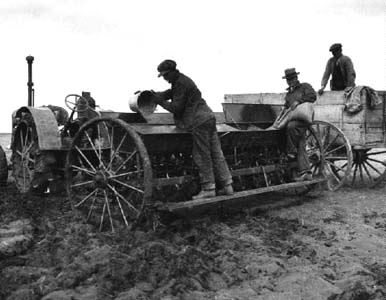Search | Image Archive | Reference | Communities | POV | Lesson Plans | Credits
 The development of the press drill was one of the major innovations in pre-1900 farming technology. Before 1900, most farmers seeded by broadcasting. Broadcast seeding, however, had its shortcomings. Much of the seed remained on the surface where it never germinated or germinated prematurely, only to be killed by frost. On the surface, it was also vulnerable to being eaten by birds or carried away on the wind.
The development of the press drill was one of the major innovations in pre-1900 farming technology. Before 1900, most farmers seeded by broadcasting. Broadcast seeding, however, had its shortcomings. Much of the seed remained on the surface where it never germinated or germinated prematurely, only to be killed by frost. On the surface, it was also vulnerable to being eaten by birds or carried away on the wind.
The invention of the seed drill dramatically improved germination. The seed drill employed a series of runners spaced at the same distance as the ploughed furrows. These runners, or drills, opened the furrow to a uniform depth before the seed was dropped. Behind the drills were a series of presses, metal discs which cut down the sides of the trench into which the seeds had been planted, covering them over.
This innovation permitted farmers to have precise control over the depth at which seeds were planted. This greater measure of control meant that fewer seeds germinated early or late, and that seeds were able to take optimum advantage of available soil moisture in a prepared seed bed. The result was that farmers were able to use less seed, and at the same time experience larger yields than under the broadcast methods.
Over the years, seed drills became larger and more sophisticated, but the technology remained substantially the same. Early drills were small enough to be pulled by a single horse, and many of these remained in use into the 1930s. The availability of steam, and later gasoline tractors, however, saw the development of larger and more efficient drills that allowed farmers to seed ever larger tracts in a single day.
Page revised: 29 August 2009